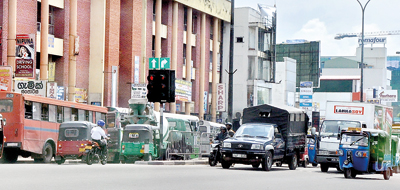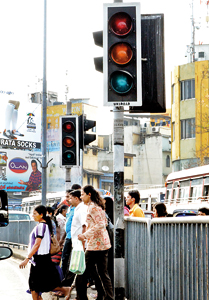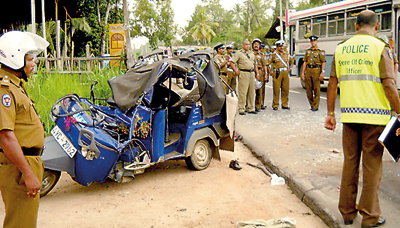News
Motorists left to manage without Police to direct traffic
Since Monday, no traffic police officers have been on duty at traffic light intersections in Colombo city; motorists are expected to obey the traffic lights.
Traffic police were withdrawn after motorists had complained that road congestion had only got worse with police officers directing traffic, SSP K. Arasaratnam, Director, Traffic Administration and Road Safety, told the Sunday Times.

Chaos or order: No police officers at the busy Borella junction. Pix by Mangala Weerasekera
The volume of traffic entering Colombo city peaks between 6.30 am and 9 am and again between 11.30 am and 2 pm; while traffic leaving Colombo peaks between 5 pm and 8 pm. These are the hours when the highest number of traffic police officers are on duty at traffic signal intersections.
Around 300,000 vehicles enter Colombo daily, mostly along the Kelaniya Bridge and the Galle Road.
Traffic congestion in the city was largely controlled by traffic lights before vehicle numbers started to escalate. Around 4.5 million vehicles were registered this year with the Motor Traffic Commission.
As traffic signal lights are programmed to blink at specific times, it was decided to switch off the traffic lights and have police officers controlling and directing the traffic.SSP Arasaratnam said that under the new directive police officers will be on duty at traffic signals to observe how motorists conduct themselves, but they will not be directing traffic. Police officers will direct traffic only at spots where there are no traffic signals.
Traffic congestion is heaviest at the Narahenpita and Kelaniya intersections, SSP Arasaratnam added.
“Traffic police officers will enforce the law if motorists fail to observe traffic rules,” he added.
Commenting on this week’s traffic plan, some motorists said the problem would be solved only when police officers were active during peak hours.
Pettah three-wheeler driver P. K. Premachandra believes there should be a Police presence wherever there are traffic signals. “I want to see the Police directing the traffic,” he said.
Hanwella resident Ashadni Premawardena said traffic police only add to the confusion, and that motorists should be allowed to follow the traffic lights. “Since Monday, things have been going quite smoothly, without the Police,” she said.
Athurugiriya private bus driver S. D. C Wijesinghe said the Police presence was necessary for motorists and pedestrians who did not obey road rules.
According to transport expert Amal Kumarage, traffic signals are not meant to be manned by the Police. Traffic signals can be programmed according to typical traffic patterns for the day and the week.
“What the Police or the Road Development Authority or the Colombo Municipal Council should do is make regular traffic counts at intersections and draw up a traffic plan that minimises waits and reduces congestion.”
“When per capita incomes crosses the US$3,000 mark, motor vehicle ownership and use grows exponentially,” Professor Kumarage said. “In cities where population density is high and road density is low, the solution is a two-pronged strategy to provide high quality public transport and to restrain use of private vehicles during peak periods in congested locations by electronic road pricing and similar instruments.”
Follow @timesonlinelk
comments powered by Disqus























